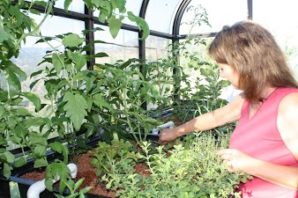
As the majority of the United States has been buried in snow for the long winter, most scientists are citing global warming. The erratic weather patterns call for our children to be as educated as possible to keep our planet sustainable for years to come. A fun and engaging way to teach children about our global ecosystem is to create your own with an aquaponics system.
“Aquaponics combines aquaculture with hydroponics to raise fish and grow plants simultaneously,” affirms Sylvia Bernstein, president of The Aquaponic Source, and author of the book “Aquaponic Gardening: A Step-By-Step Guide to Raising Vegetables and Fish Together” (New Society Publishers, October 2011). “It’s an accessible, interactive way to teach kids about ecosystems and responsibility, especially during a week as important as Environmental Education Week.”
Environmental Education Week is April 13-19, 2014, and is dedicated to educating children from kindergarten to seniors in high school about the importance of being environmentally-aware, including how to make strides towards achieving green living and spreading sustainability.
Such goals can be achieved by integrating an aquaponics system into the classroom to teach lessons such as:
- Educational. Aquaponic systems are fantastic teaching tools for a variety of science topics, including botany, chemistry, physics, biology and zoology. Plus, through the implementation of an aquaponic garden, those responsible for the upkeep of the system will get a first-hand look at how an ecosystem works. The dependency of the fish on the plants for filtration, and the plants on the fish for nutrients is an educational experience that teaches both children and adults about the importance of sustainability and green living.
- Water is a finite resource — even though about 70 percent of the Earth’s surface is covered by water, less than one percent is available for human use. At least 36 states are projecting water shortages in the future, according to the US Environmental Protection Agency. An aquaponic garden, uses less than 10% of the water of similar sized soil-based gardens, saving money and water from the constant need to water your plants daily.
- Money Saver. According to a study at North Dakota State University, the United States spends $2.5 billion on food gardens annually. Growing your own vegetables and herbs can save you some pocket money when you go to the grocery store, plus it can improve your health. An aquaponic garden can supply you with a variety of greens and those who wish to eat their fish, can raise fish, such as tilapia and catfish, for food..
“Aquaponic systems are available in various sizes, from those designed for large greenhouses to small, fish-bowl size that will fit on a desk,” affirms Bernstein. “The systems are a great tool and resource to help children learn about the importance and function of our planetary ecosystem during Environmental Education Week and every other week of the year!”
For more information, visit the website at www.theaquaponicsource.com

